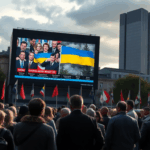Table of Contents
Indonesia is stepping into the spotlight as a crucial player in the global critical minerals market, especially with shifting trade policies and a rising demand from the United States. Recent discussions between U.S. officials and Indonesian leaders shine a light on the opportunities presented by Indonesia’s abundant mineral resources, which are essential for various high-tech and green technologies.
As the U.S. looks to secure critical minerals for its electronics and aerospace industries, Indonesia’s offer couldn’t come at a better time, potentially reshaping economic ties between the two nations. But what does this mean for investors?
Market Overview: Indonesia’s Critical Minerals
In today’s fast-paced global trade environment, Indonesia’s push for collaboration in the critical minerals sector stands out. The country boasts vast deposits of essential minerals like nickel, copper, and rare earth elements—key components for modern technology and electric vehicles.
This backdrop is further complicated by President Trump’s trade actions, which threaten hefty tariffs on Indonesian exports unless negotiations turn favorable. Who wouldn’t want to keep those costs down?
Earlier this year, the announcement of tariffs included a temporary reprieve for discussions, but the looming 32% tariff adds a sense of urgency.
Coordinating Minister for Economic Affairs, Airlangga Hartarto, has framed Indonesia’s current offer to the U.S. as a strategic move to dodge these steep tariffs. By diving into conversations about investment opportunities, Indonesia is positioning itself as a key supplier of critical minerals to the American market.
Isn’t it fascinating how trade dynamics can shift so quickly?
The economic stakes are high. Data on mineral exports and the growing demand for electric vehicles and renewable energy tech highlight the crucial role Indonesia plays in this landscape. The U.S.
isn’t just after minerals; it’s also keen on establishing a secure and sustainable supply chain, reducing dependence on other countries. This strategic positioning allows Indonesia to negotiate terms that could be a win-win for both parties, enhancing investment flows into its mineral sector.
Key Opportunities for Investment
Airlangga pointed out the importance of copper in the U.S. electronics, defense, and aerospace sectors, emphasizing Indonesia’s strategic edge in this arena. The country’s critical mineral ecosystem, especially its mining and processing capabilities, presents a compelling case for American investors eager to make their mark in the region. Are you ready to explore these opportunities?
The proposal also introduces the concept of brownfield projects, which involve leasing existing facilities rather than building new ones. This strategy not only reduces initial capital expenditures for investors but also allows for faster integration into the supply chain. Collaborating with established companies like Freeport provides a robust foundation for these ventures, enabling investors to tap into existing infrastructure and expertise. Talk about a smart move!
Additionally, the surging demand for nickel—especially with the rise of electric vehicles—positions Indonesia as a leading supplier on the global stage. As the automotive industry pivots towards electrification, the need for dependable nickel sources is only set to grow. With large reserves, Indonesian mines are primed to meet this demand, making investments in these resources particularly appealing. Who wouldn’t want to jump on that bandwagon?
Long-term Outlook and Strategic Considerations
Looking ahead, the significance of Indonesia in the critical minerals landscape is hard to overstate. The country’s ability to navigate international trade relationships while maximizing its mineral wealth will be key in the upcoming years. For American investors, this represents a unique chance to engage with a market rich in resources and increasingly aligned with sustainable practices. Exciting, right?
As Indonesia works to enhance its mining regulations and boost environmental standards, staying informed about regulatory changes and sustainability initiatives will be essential for investors. Engaging with local stakeholders and grasping the socio-economic landscape will be vital in ensuring successful investments. After all, knowledge is power!
In conclusion, the evolving dialogue between Indonesia and the U.S. regarding critical minerals marks a promising chapter for investment in the region. As both nations aim to secure their economic futures, the opportunities arising from this partnership could lead to significant advancements in technology and sustainability, benefiting investors and the global market alike. Are you ready to be part of this exciting journey?





